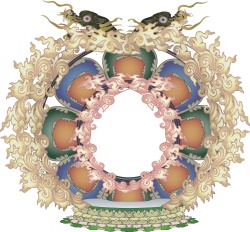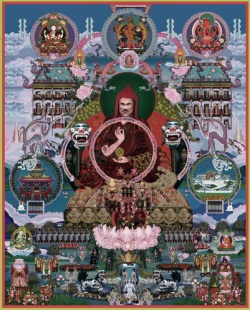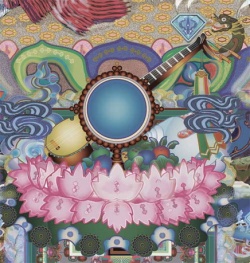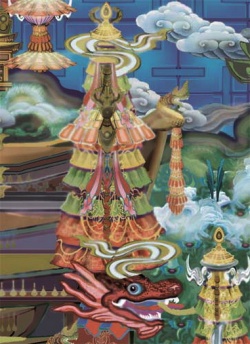Deity Meditation: Meditation Practices of Tibetan Buddhism
DEITY MEDITATION is a form of meditation that utilizes several of the basic concepts of Buddhism—that we have the power to change our minds, and with that, to change our perception of both ourselves and the world in which we live. Deity meditation comes from the Vajrayana or Diamond Vehicle taught by the Buddha, which incorporates the Hinayana and Mahayana practices and builds upon them. In deity meditation, we visualize ourselves as enlightened buddhas or bodhisattvas, and the world around us as an enlightened paradise. We recite mantras to purify our speech and identify it with sacred sound, and meditate on ultimate truth to purify our minds and identify the m with the Buddha nature which is our birthright. B y doing this, our entire mental outlook is benefited and uplifted. We come closer to recognizing our own innate enlighten ed nature, and slowly become more able to relate to and control our thoughts and feelings. Deity meditation liturgies—called sadhanas—incorporate both prayers of aspiration and a description of the process of imagining ourselves to be the enlightened deity of the particular practice. As there are many buddhas and bodhisattvas with whom practitioners can relate , there are many, many sadhanas.
Deity Meditation Practice on Buddhas and Bodhisattvas
Visualizing Deities and Reciting Mantras in Vajrayana, Dharma Paths, The Two Phases of Meditation in Vajrayana:
Creation and Completion, Chenrezig, Lord of Love, Bokar Rinpoche,
Vajrayana meditations are divided into two phases: the phase of creation and the phase of completion. The phase of creation refers to the first part of the meditation during which one mentally creates the appearance of the deity. The phase of completion refers to the end of the meditation during whiho ne dissolves the appearances into emptiness.
One then dwells in the nature of the mind that is simultaneously an absence of thought and an experience of joy. When a wave forms on the surface of the ocean, it m ay appear to be something other than the ocean. However, when it plunges, it descends back into the ocean which is it sown nature . Similarly , the phases of creation and completion are in essence no t separated. As with the wave and the ocean, they participate in the same nature. The phase of creation corresponds to the wave that rises up; the phase of completion to the wave that plunges back into the ocean. In both cases, it is the same mind t hat meditates; there are not two different realities.
I f one does not well understand this relationship, one may perhaps compare the phase of creation to building a house and the phase of completion to its destruction. For beginners, bot h phases have, it is true, distinct aspects. We first accomplish the phase of creation during which we visualize the deity and recite the mantra. At the end of this phase, we do the phase of completion, dissolving all appearances into emptiness. At a more advanced level, however, the two phases a re undifferentiated. The phase of creation begins with the emptiness of mind from which one creates an image.
For example, you can evoke an image of the city of Paris in your mind . You see the buildings that you know , the streets that are familiar to you, and so on All this appears clearly. While t his manifestation occurs, it is; however, empty , devoid of any material reality or independent entity. This emptiness is the phase of completion. The two phases are present simultaneously. The visualized appearances are empty and even though empty, they still occur.
This is the union of manifestation and emptiness. When we visualize Chenrezig, we clearly see his face, arms, jewels, and the different colors; this is the phase of creation. At the same time, Chenrezig is without material existence; this is the phase of completion. Likewise, sounds are simultaneously sound and emptiness; thoughts are simultaneously consciousness and emptiness. Each thought that arises in our mind actually contains in itself the two phases of creation and completion. This is the nature of the two phases. We now will see how the meditation of Chenrezig "functions"; how it supports our spiritual progress in general, the specific contributions of the two phases, and the characteristics of the phase of creation. Deity Meditation: Meditation Practices of Tibetan Buddhism Deity Meditation The Purpose of Deity Meditation The “work” of the Buddhist path is transforming confusion in to primordial awareness (i.e., Buddahood). Theoretically, this is easy.
In our ordinary state , our mind is clouded and confused; but if we recognize our mind’s true nature, we experience primordial awareness. However , on a practical level, this does not happen automatically. One must use skillful means to transform discursive thought into enlightened awareness. In the Vajrayana, one such skillful means is Development and Fulfillment Stage Meditation. In Tibetan, the words are “Kye Rim” for Development (also Generation or Creation), and “Dzog Rim” for Fulfillment (or Completion). Now, our three faculties of body, speech, and mind are obscured by basic ignorance . To transform these, we must become physically, verbally and mentally aware. Therefore, in Vajrayana, we use all three of these faculties.
Our Physical Body
We are very attached to our physical body, and think of it as being pure, permanent, and real. Yet, our body is only temporary.
This confusion obstructs the arising of primordial awareness. We must come to see that the body is something that appear s without having self-nature. The body is the Form Aspect of consciousness. In Vajrayana, we identify with a pure and enlightened form, like the bodhisattvas Tara and Chenrezig. We put aside our concept of our body for the body of a enlightened being, but we do not make this form solid or substantial. We make t h e visualized form of our body insubstantial and made of light. If we completely identify with this form, the experience is called “The Union of Appearance and Emptiness.”
Our Speech
Although it could be considered intangible, we actually relate to our speech as something solid and real. Because we are so attached to what we say, our speech is given such a power.
However, ultimately, our speech is without true reality. In Vajrayana, we meditate on mantra, the enlightened speech of enlightened beings. If we completely identify with this speech, the experience is called “The Union of Sound and Emptiness.” As such, it has n o intrinsic reality, but is a manifestation of pure sound, arising simultaneously with emptiness. Through the practice of Mantra, we no longer cling to t h e reality of speech, so the confusion of speech is transformed .
Our Mind
Normally, we believe our thoughts are real and substantial. In believing this week, we misunderstand our mind’s true nature . In Vajrayana, our mind is concentrated on the visualization of the enlightened beings and its mantra and “seed syllable,” which is usually located in the heart of the enlightened being.
The seed syllable is considered to be the essence of the enlightened being upon whom we are meditating . While meditating on this mantra and seed syllable in the heart, we see lights going out from the mantra and seed syllable, making offerings to enlightened beings above and blessing sentient beings below. Meanwhile, our mind rests in its own nature of emptiness. After practicing this for some time, a change will occur; we will have the experience that anything arising i n the mind arises from and dissolves back into emptiness. For that time, we experience only emptiness—a state called, “
The Union of Awareness and Emptiness.” This is Mahamudra, the “great seal” of emptiness. As the end of our meditation session, we dissolve o ur visualization into a formless state and simply rest the mind evenly in its own nature . Then, we can experience all three of these – body, speech and mind – as arising from primordial awareness. In this way, we gather all aspects of our experience into one, the emptiness of mind from which everything arises.



